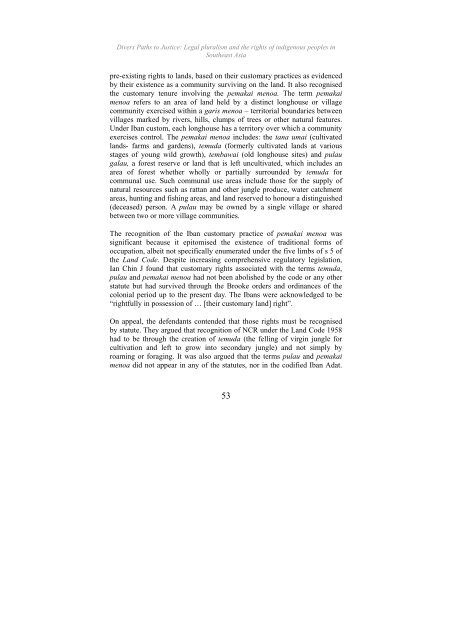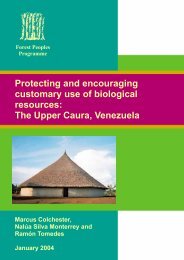Divers Paths to Justice - English - Forest Peoples Programme
Divers Paths to Justice - English - Forest Peoples Programme
Divers Paths to Justice - English - Forest Peoples Programme
Create successful ePaper yourself
Turn your PDF publications into a flip-book with our unique Google optimized e-Paper software.
<strong>Divers</strong> <strong>Paths</strong> <strong>to</strong> <strong>Justice</strong>: Legal pluralism and the rights of indigenous peoples inSoutheast Asiapre-existing rights <strong>to</strong> lands, based on their cus<strong>to</strong>mary practices as evidencedby their existence as a community surviving on the land. It also recognisedthe cus<strong>to</strong>mary tenure involving the pemakai menoa. The term pemakaimenoa refers <strong>to</strong> an area of land held by a distinct longhouse or villagecommunity exercised within a garis menoa – terri<strong>to</strong>rial boundaries betweenvillages marked by rivers, hills, clumps of trees or other natural features.Under Iban cus<strong>to</strong>m, each longhouse has a terri<strong>to</strong>ry over which a communityexercises control. The pemakai menoa includes: the tana umai (cultivatedlands- farms and gardens), temuda (formerly cultivated lands at variousstages of young wild growth), tembawai (old longhouse sites) and pulaugalau, a forest reserve or land that is left uncultivated, which includes anarea of forest whether wholly or partially surrounded by temuda forcommunal use. Such communal use areas include those for the supply ofnatural resources such as rattan and other jungle produce, water catchmentareas, hunting and fishing areas, and land reserved <strong>to</strong> honour a distinguished(deceased) person. A pulau may be owned by a single village or sharedbetween two or more village communities.The recognition of the Iban cus<strong>to</strong>mary practice of pemakai menoa wassignificant because it epi<strong>to</strong>mised the existence of traditional forms ofoccupation, albeit not specifically enumerated under the five limbs of s 5 ofthe Land Code. Despite increasing comprehensive regula<strong>to</strong>ry legislation,Ian Chin J found that cus<strong>to</strong>mary rights associated with the terms temuda,pulau and pemakai menoa had not been abolished by the code or any otherstatute but had survived through the Brooke orders and ordinances of thecolonial period up <strong>to</strong> the present day. The Ibans were acknowledged <strong>to</strong> be“rightfully in possession of … [their cus<strong>to</strong>mary land] right”.On appeal, the defendants contended that those rights must be recognisedby statute. They argued that recognition of NCR under the Land Code 1958had <strong>to</strong> be through the creation of temuda (the felling of virgin jungle forcultivation and left <strong>to</strong> grow in<strong>to</strong> secondary jungle) and not simply byroaming or foraging. It was also argued that the terms pulau and pemakaimenoa did not appear in any of the statutes, nor in the codified Iban Adat.53
















